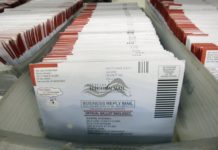Some will vote by mail. Some will vote early. Some will go old-school and vote on the actual election day. Some won’t vote at all.
But slightly more than 13 million Floridians are registered to vote in advance of the Aug. 28 primary elections, according to new figures posted online by the state Division of Elections. Democrats outnumber Republicans, but just barely, as both parties gear up for a fierce battle in November for a U.S. Senate seat and the governor’s office.
Here are five takeaways from the new voter-registration numbers, which reflect the primary-election “book closing” on July 30:
THE BIG PICTURE: As Florida’s population has continued to grow, so has the number of voters, with 13,013,657 registered to cast ballots in the primaries. By comparison, 12.37 million were registered to vote in the 2016 primaries, and 11.8 million were registered to vote in the 2014 primaries.
Registered Democrats outnumber registered Republicans, but not by a lot — 4,839,434 to 4,594,133. While both parties have seen registration increases since the 2016 primaries, the Democratic margin is about the same as it was two years ago.
NO LABELS, PLEASE: Voters who aren’t registered with the Democratic or Republican parties won’t be able to cast ballots in many primary races, including the marquee race for governor. But that hasn’t stopped the trend of Floridians ditching the donkeys and the elephants and registering “no party affiliation.”
The total of so-called NPA voters has climbed to 3,493,494 — or about 27 percent of the electorate. That is up from slightly more than 2.91 million voters, or about 23.6 percent, during the 2016 primaries.
DEMOCRATIC DOMINANCE: Conventional wisdom has long held that Democrats look to South Florida when they need votes. And there’s good reason for that: Miami-Dade County has 586,648 registered Democrats, Broward County has 577,248, and Palm Beach County has 387,445 — nearly a third of all of the registered Democrats in the state.
It’s also no wonder that Democrats focus on the Orlando area. In Orange and Osceola counties, registered Democrats now outnumber Republicans by 161,000 voters. With both parties focusing heavily this year on attracting Hispanic voters, Democrats also hold about a 100,000-voter edge in Orange and Osceola among Latinos.
GOP HEAVEN: Registered Republicans are outnumbered by Democrats in each of the seven most-populated counties — Broward, Duval, Hillsborough, Miami-Dade, Orange, Palm Beach and Pinellas (though the GOP trails by fewer than, 1,000 voters in Pinellas.) But the GOP has been successful for the past two decades, at least in part, because it has dominated regions such as North Florida, Southwest Florida and many suburban areas.
The new numbers bear that out. For example, in Northwest Florida, registered Republicans make up more than half of the voters in Bay, Holmes, Okaloosa, Santa Rosa, Walton and Washington counties. The same holds true in Northeast Florida in Baker, Clay, Nassau and St. Johns counties. It also goes for Sumter County, which is home to much of the massive Villages retirement community, and Collier County in Southwest Florida.
DON’T FORGET THE LITTLE GUYS: Much of the attention during this year’s campaign focuses on candidates going to large media markets and party strongholds as they try to amass votes. But the new registration numbers also give a glimpse of smaller, rural counties that can get lost in the debate.
Nine counties — Calhoun, Dixie, Franklin, Glades, Hamilton, Jefferson, Lafayette, Liberty and Union counties — each have fewer than 10,000 registered voters. The smallest are Lafayette, with 4,312 voters, and Liberty, with 4,365, followed by Glades, with 6,751. Registered Democrats outnumber Republicans in each of the nine counties, though GOP President Donald Trump carried all of the counties in 2016.














